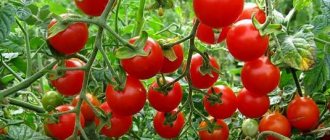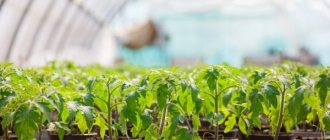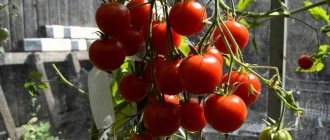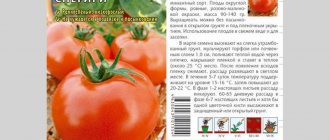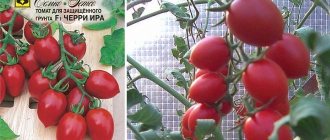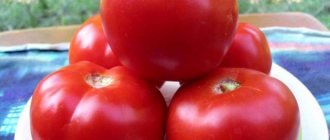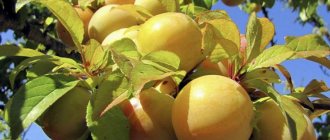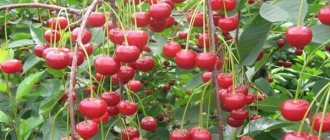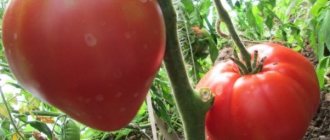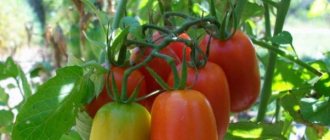general information
Description of the variety: not a hybrid, so you can collect the seeds. Early. Cultivation takes 85 - 100 days - this is the time from the first shoots to the harvesting of the fruits. Tomatoes can be harvested from the beginning of July until frost.
Description of the bushes: high yield - up to 2 kg of tomatoes are harvested from the bush. The bushes are indeterminate, 1.5–2 m high. The leaves grow sparsely, are medium-sized, dark green, and slightly corrugated. The first brush is formed above the 8th - 9th sheet, and then every 3 sheets. Tomatoes in a bunch do not ripen at the same time.
The variety is immune to cladosporiosis. Not resistant to fusarium and tobacco mosaic. Since the variety is early ripening, it does not have time to suffer from late blight and root rot. Bushes are rarely attacked by parasites.
Characteristics of the fruits: round, small, scarlet, their weight is 15 - 35 g, externally they resemble cherry fruits. In one brush - 20 - 35 pieces. The skin is thin and cracks if the tomatoes are overripe. The fruit has 2–3 seed chambers. The content of dry substances and sugars is 10 – 12%. Great dessert taste. Strengthen the heart and blood vessels, normalize metabolic processes. Considered to prevent cancer. But the fruits of this variety are difficult to transport. Stored in the refrigerator for about a month. The fruits are eaten fresh, put in salads, canned, and salted.
Only ripe tomatoes are harvested, then the fruits retain their taste. Reviews about the variety are enthusiastic. Everyone loves the sweet taste of small tomatoes. Thus, reviews from the Smirnov family from the Moscow region: “The bushes have a wonderful appearance, we were pleased with the harvest.
The grandchildren really liked the tomatoes.”
Characteristics and description
The Red Cherry variety is expressed in the following characteristics:
- demanding of lighting;
- resistant to pests and low temperatures;
- early ripening - fruits can be obtained 90-100 days after germination;
- there are no strict climatic conditions for ripening;
- protection against cladosporiosis, late blight.
Due to its inherent properties, this tomato is recommended for cultivation in any region of Russia, both in open ground and indoors.
Bush
Red cherry tomato bushes:
- indeterminate;
- in favorable conditions they can reach a height of 2-3 meters;
- with small, smooth leaves with a dark green tint. Rarely grow;
- stipules are absent.
Due to their large size, the bushes are demanding on tying and pinching.
Fruit
Cherry tomatoes of this variety are distinguished by:
- productivity - from one bush you can get up to 2 kilograms of tomatoes;
- small sizes;
- color – scarlet;
- shape – round;
- weight – within 15-40 grams;
- the skin is thin, prone to cracking when overripe;
- number of seed chambers - 2-3 pieces in one fruit;
- dessert taste;
- intolerance to transportation;
- short storage period - no more than a month in a refrigerator;
- appearance - similar to cherry fruits (which justifies the name).
There is a positive effect on the cardiovascular system and metabolic processes.
Advantages and disadvantages
Main advantages:
- Unpretentious, easy to grow.
- Tied with whole tassels.
- They ripen early.
- All Cherry tomatoes have a dessert, sweet taste.
- Immunity to diseases such as brown spot, root rot and late blight.
- The variety produces high yields.
- Parasites rarely attack.
- The variety is resistant to temperature changes.
- Can be preserved with brushes.
The disadvantages include:
- The bushes are tall.
- Growing indeterminate varieties necessarily involves tying and pinching.
- The variety requires good lighting.
- The variety is not resistant to tobacco mosaic and fusarium.
- Tomatoes are sensitive to both excess and lack of moisture.
- Tomatoes cannot be stored for a long time and should not be transported.
See also
Characteristics and description of the tomato variety Dobrynya NikitichRead
Diseases and pests
Fusarium and tobacco mosaic affect the leaves and reduce the plant's immunity. An infected plant cannot be cured; it dies. To prevent the appearance of these dangerous diseases, it is necessary to avoid waterlogging of the soil, provide the plant with good lighting and carefully carry out pinching.
Red cherry is a wonderful variety that does not require much effort when growing. To get a good harvest, standard conditions are sufficient: gartering, pinching, fertilizing and watering.
| Mid-season | Mid-early | Late ripening |
| Anastasia | Budenovka | Premier |
| Raspberry wine | Mystery of nature | Grapefruit |
| Royal gift | Pink King | De Barao the Giant |
| Malachite Box | Cardinal | De Barao |
| Pink heart | Babushkino | Yusupovsky |
| Cypress | Lev Tolstoy | Altaic |
| Giant raspberry | Danko | Rocket |
If you find an error, please select a piece of text and press Ctrl+Enter.
Sowing seeds
Cultivation begins with sowing seeds for seedlings. Seeds are sown from March 20 to April 5. Select the seeds by pouring them into a 5% salt solution. Wait 5 minutes. - bad seeds will float, and good ones will sink to the bottom. Select the seeds that remain at the bottom and rinse them with clean water.
If you purchased seeds at the market, then soak them for 30 minutes. into a pink solution of potassium permanganate, then wash and dry.
Pour fertile soil into the boxes from equal parts of turf soil, humus, and river sand. It is advised to water the soil with a weak solution of potassium permanganate or calcine it in the oven.
Water the soil. Make grooves 1 cm deep, the space between the grooves is 4 - 5 cm. Pour seeds into the grooves after 1 cm. Sprinkle with soil. Cover the plantings with film and place in a warm place. When the first shoots sprout, continue growing by removing the film and exposing the plantings to light.
When there are 2 - 3 true leaves, the seedlings are picked. They are carefully dug up, trying not to damage the roots, and then placed in cups with a diameter of 8 - 12 cm.
Seedlings require additional lighting. You can use fluorescent lamps or special phytolamps.
After 3–4 true leaves appear, you need to place the seedlings on the balcony for 15 minutes. Choose a place for the seedlings where there is no direct sunlight and no drafts. Before planting, you can leave the seedlings on the balcony overnight. When hardening, the bush may turn purple - this is a natural reaction.
Features of agricultural technology
Like all tomatoes, they require growing by seedlings. Let's look at the basic requirements at this stage.
Humidity and temperature
Seed material must be thoroughly and properly dried. Only in this case can you get quick and friendly shoots. After this, regular moderate moisture is required; it is advisable to avoid overwatering. The air temperature requirements in the room for keeping seedlings are not lower than 25-28C. If these conditions are met, shoots should appear within 6-8 days.
Lighting
Tomatoes are long-day sunny plants, so in spring they require additional lighting. These can be ordinary fluorescent lamps (fluorescent) or special phytolamps. Keeping trays of tomato seedlings on the windowsill, as is usually the case, is not always justified. Cold air enters not only through mini-cracks in the frame, but at close range it can also be felt from the window glass, which, combined with direct sunlight at lunchtime, creates not the best conditions for growth.
It is better to organize additional lighting, but place the containers in a more comfortable place.
Soil requirement
The culture is responsive to nutritious fertile soil with neutral acidity. The ready-made composition offered at specialized retail outlets will also work. But you can prepare the soil yourself by adding 1-2 parts of clean river sand to ordinary black soil. It is advisable to take the usual preventive measures to exclude infection - watering with a weak manganese solution, calcining or freezing the soil prepared for sowing seed material.
Seed preparation
You should choose healthy, full-bodied tomato seeds for planting. A day before planting, it is advisable to treat them with a weak manganese solution, immersing them in it for 5-10 minutes. Then drain the solution and dry the seed well, after which it is ready for planting.
The prepared seeds should be placed in moistened grooves, covered with a layer of soil of no more than 0.5 cm, then gently tamp the surface and water very carefully, preventing the seeds from being washed out.
Hardening off seedlings
By the time it is ready to be transferred to open ground, it is advisable to carry out measures to harden the plants so that it, as they say, gets over the disease. After 3-4 true leaves form on the stem, you should gradually begin to take the trays outside, starting from 15-20 minutes. To do this, you need to choose a place protected from direct sunlight and drafts.
Aquarius and Pisces: compatibility of men and women in love relationships, marriage and friendship
On the second day, the plants can “walk” for an hour, and before transplanting, you can try leaving them overnight if it does not promise to be cold.
When hardened, the tomato plant will change color and may take on a purple hue. There is no need to be scared - this is an expected reaction.
Planting seedlings on the site
Planting on the site is done as soon as the threat of frost has passed. They can be planted in the greenhouse in mid-May, and on the plot in early June.
They dig holes, making an indentation of 0.6 m. As a result, 2–3 bushes grow per 1 m². A handful of humus is poured into each hole. A peg is driven into the center of the hole so that it rises 2 m above ground level. The hole is watered and the seedling is placed in it at an angle. The roots and some part of the stem are covered with soil and watered again.
There is no need to water for the first week, since during planting there is enough water for the seedlings to take root. 3 - 4 days after planting the seedlings, the seedlings are tied to pegs. Planted bushes are watered after the top layer of soil has dried so that there are no changes in humidity, as this leads to a deterioration in the taste of the tomatoes. Watering is done approximately 2 times a week.
Next, you need to loosen the ground so that a crust does not appear. If there is a lack of moisture, the tomatoes dry out and turn brownish, and if there is too much water, they become watery.
Caring for Red Cherry tomato bushes includes plucking off the shoots. This is done after the 5th inflorescence has grown. In early August, pinch off the top of the stem. By this time, 8 - 9 brushes should grow. After the last brush, leave 2 leaves, and then pinch them off.
See also
Characteristics of the tomato variety Honey Heart, its yieldRead
The first time they are fed 2 - 3 weeks after planting the seedlings, the second and third times they are fertilized when they ripen. It is better to feed the first time with an infusion of grass and manure. Then pour 200 g of ash into a ten-liter bucket of water. You can feed tomatoes with yeast.
Harvest tomatoes when the bunches are 80% ripe.
Specifics of cultivation
Sowing seeds for seedlings is carried out in the first months of spring. When five inflorescences appear, all stepsons must be removed. The stem is pinched after more than 8 clusters have formed. A couple of leaves just above the outermost brush should be left.
Tomato Red Cherry requires obligatory gartering and pinching
In May, the seedlings are transferred to open ground. The plant is planted according to the principle: 3 bushes per 1 sq.m. Water thoroughly, at least twice a week. Fertilizing with complex fertilizers (Agricola, Kemira, Effecton are suitable) is required once a week, and is combined with one of the waterings. During the formation of the ovary, you can add ammonium nitrate with wood ash.
Other varieties of tomatoes Cherry
In addition to the Red Cherry tomato variety, Aelita sells Black Cherry tomato. This is also an indeterminate variety, the bush is up to 2 m in height. The variety was bred in the USA quite recently, at the beginning of the 21st century. It began to be sold in Russia in 2009. 5–6 kg of fruits are collected from one bush. The weight of the tomato is 25 g. The fruits are very dark cherry in color. They taste sweet, like candy. There are 5 – 9 pieces in one brush. The fruits are harvested 112–120 days after the sprouts appear.
True, this variety has a disadvantage - the fruits crack when fully ripe. These tomatoes are even added to fruit salads. Growing has its own difference - it is not recommended to pick stepsons from bushes. To get an excellent harvest, tie the bushes to trellises, and all the stepsons should be in the same plane. Leave 3 fruit clusters on each stepson and tear off the rest.
Reviews from the Ivanov family from the Oryol region: “The tomatoes are sweet, very tasty. The bushes were fertilized with organic matter, and when the fruits appeared, wood ash was sprinkled.”
The Gavrish company sells pink cherry tomato seeds. This is an early ripening variety, the tomatoes are very sweet. The Yellow Cherry tomato has also been bred.
To grow a Red Cherry tomato, you need to tie up the bushes, pruning, watering, feeding, and pinching the top of the stem. It must be remembered that the variety needs good lighting and constant watering, but in such a way as to avoid drought or waterlogging of the soil.
Pros and cons – is it worth planting?
As advantages of the variety:
- unpretentiousness to growing conditions;
- they ripen quickly, which allows you to get a harvest even in regions with short summers;
- pleasant sweet taste.;
- productivity;
- protection against parasites and some diseases;
- When preserving, you can use whole brushes.
As for the disadvantages:
- excessive height of bushes, requiring additional procedures;
- the need to provide good lighting;
- lack of resistance to certain diseases (fusarium);
- intolerance to transportation;
- short duration of storage;
- susceptibility to lack or excess of moisture.
Most of the shortcomings can be eliminated with the help of additional measures. The Red Cherry tomato is suitable for fresh consumption for 3-4 weeks or for home canning.
Care and feeding
Caring for cherry tomatoes, both of this and other varieties, is basically no different from the activities common to this crop. This includes weeding, watering, and aeration of the soil. But, unlike low-growing varieties, in this case pinching and timely garter are required. The height of the supports in this case should immediately be calculated at least 2 m.
Fertilizers are used as usual for this crop. You can also use yeast and boric acid as a top dressing. This will reduce the risk of infectious diseases, in particular late blight.
